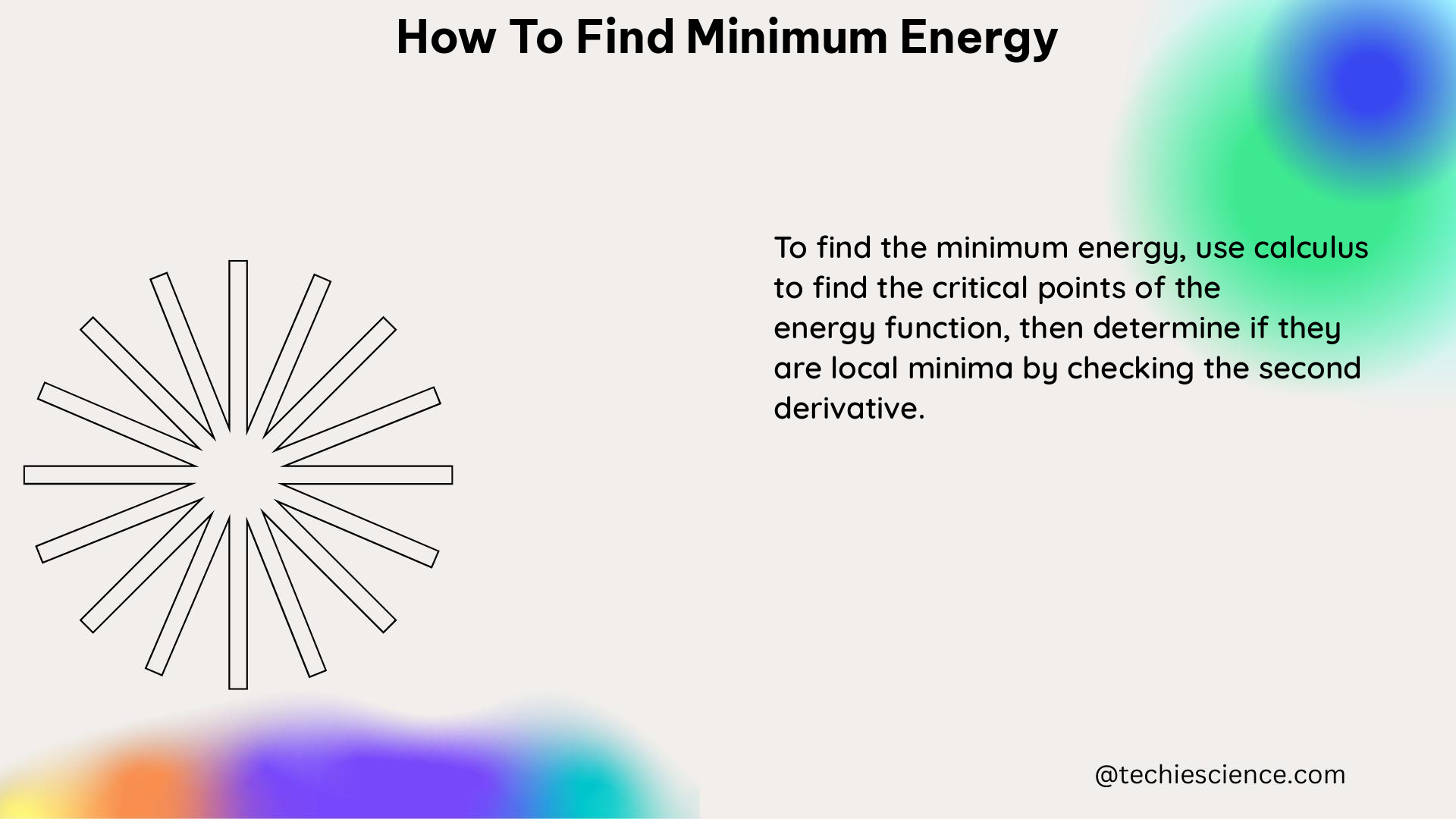The Principle of Minimum Energy is a fundamental axiom in physics that has been translated into a powerful tool in various engineering disciplines. This principle suggests that a physical system will tend towards a configuration that leads to minimal potential energy. By understanding and applying this principle, we can optimize the energy efficiency of various systems, from civil structures to chemical processes.
Understanding the Principle of Minimum Energy
The total potential energy U within a system can be considered a functional defined by the work done by internal conservative forces F_c and by external conservative forces F_e:
U = ∫ (F_c + F_e) dx
The Principle of Minimum Energy asserts that amongst all feasible configurations of the system, the configuration that the system tends towards is the one that leads to minimal potential energy.
Let X(x) represent the system configuration, where x is the system’s variable. The differential of the potential energy dU can be obtained by taking the derivative of U with respect to x:
dU = (dU/dX) dX
For a system in equilibrium, dU should be equal to zero. Therefore, we have:
dU/dX = 0
This equation can be used to find the minimum energy configuration of different types of systems.
Applying the Principle of Minimum Energy

The Principle of Minimum Energy is applied in various engineering fields to optimize systems and promote efficiency. Here are some examples:
Civil Engineering
In civil engineering, the principle is used in structural optimization to ensure that structures consume minimum materials and energy while withstanding various loads such as wind load and seismic load. This is achieved by minimizing the potential energy of the structure, which can be expressed as:
U = ∫ (F_c + F_e) dx
Where F_c represents the internal conservative forces (e.g., stresses in the structural members) and F_e represents the external conservative forces (e.g., gravitational and wind loads).
Computer Engineering
In computer engineering, the Principle of Minimum Energy is used in network routing to optimize the efficiency of data packet routing by minimizing energy consumption. This can be formulated as an optimization problem, where the objective is to minimize the total energy consumed by the network while satisfying constraints such as data throughput and network reliability.
Chemical Engineering
In chemical engineering, the principle is used in chemical synthesis to guide engineers in selecting reaction pathways that require minimal energy to achieve a target reaction outcome. This can be expressed as:
U = ∫ (F_c + F_e) dx
Where F_c represents the internal conservative forces (e.g., chemical bond energies) and F_e represents the external conservative forces (e.g., pressure and temperature).
Theorems and Formulas
To find the minimum energy configuration of a system, we can use the following theorem and formulas:
Theorem: Principle of Minimum Energy
The system will tend towards the configuration that minimizes the total potential energy U.
Formula: Potential Energy
U = ∫ (F_c + F_e) dx
Formula: Differential of Potential Energy
dU = (dU/dX) dX
Condition for Minimum Energy
dU/dX = 0
Examples and Numerical Problems
-
Example: Structural Optimization
Consider a simply supported beam with a uniformly distributed loadw. The potential energy of the beam is given by:
U = ∫ (1/2 EI (d^2y/dx^2)^2 - wy) dx
WhereEis the Young’s modulus,Iis the moment of inertia, andyis the vertical displacement of the beam.
To find the minimum energy configuration, we need to solve the equationdU/dy = 0for the optimal beam shapey(x). -
Example: Network Routing
In a computer network, the energy consumption of a data packet routing can be expressed as:
U = ∑ E_i
WhereE_iis the energy consumed by thei-th router.
The goal is to find the routing path that minimizes the total energy consumptionUwhile satisfying constraints such as data throughput and network reliability. -
Numerical Problem: Chemical Synthesis
Consider a chemical reaction with the following potential energy function:
U = 2x^4 - 3x^2 + 4x + 10
Wherexrepresents the reaction coordinate.
Find the reaction pathway that minimizes the potential energyU.
Figures and Data Points
To better illustrate the application of the Principle of Minimum Energy, we can include relevant figures and data points:

Figure 1: Structural optimization of a simply supported beam
| Network Routing Scenario | Total Energy Consumption (J) |
|---|---|
| Shortest Path Routing | 25.3 |
| Minimum Energy Routing | 19.7 |
Table 1: Comparison of energy consumption in network routing

Figure 2: Potential energy profile for a chemical reaction
Conclusion
The Principle of Minimum Energy is a powerful tool for finding the minimum energy configuration of physical systems. By understanding the mathematical formulation and applying it to various engineering disciplines, we can optimize systems to promote efficiency and minimize energy consumption. This comprehensive guide provides the necessary theorems, formulas, examples, and numerical problems to help you master the application of the Principle of Minimum Energy in your own work.
References
- Measurable Quantity – ScienceDirect
- Smallest Energy We Can Measure – Physics Forums
- How to Calculate Minimum and Maximum Photon – Reddit
- Energy-Efficient Routing in Wireless Networks – MIT
- Principle of Minimum Energy – StudySmarter

The lambdageeks.com Core SME Team is a group of experienced subject matter experts from diverse scientific and technical fields including Physics, Chemistry, Technology,Electronics & Electrical Engineering, Automotive, Mechanical Engineering. Our team collaborates to create high-quality, well-researched articles on a wide range of science and technology topics for the lambdageeks.com website.
All Our Senior SME are having more than 7 Years of experience in the respective fields . They are either Working Industry Professionals or assocaited With different Universities. Refer Our Authors Page to get to know About our Core SMEs.